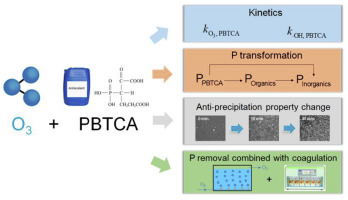Water Research ( IF 11.4 ) Pub Date : 2018-10-17 , DOI: 10.1016/j.watres.2018.10.038 Zi-Bin Xu , Wen-Long Wang , Nan Huang , Qian-Yuan Wu , Min-Yong Lee , Hong-Ying Hu

|
2-Phosphonobutane-1,2,4-tricarboxylic acid (PBTCA) is an antiscalant that is widely used in reverse osmosis (RO) systems. Because of its high concentration in RO concentrate, eutrophication risk and anti-precipitation properties may affect subsequent treatments, therefore treatment strategies are needed to eliminate such substances. In this study, PBTCA was degraded by ozonation. The results show that PBTCA reacted with ozone molecules and hydroxyl radicals, with second-order rate constants of (0.12 ± 0.002) and (7.83 ± 1.51) × 108 L mol−1 s−1, respectively. The phosphorus in PBTCA (PP) was transformed into organic phosphorus except for PBTCA (PO), and inorganic phosphorus (PI); PO was further transformed into PI. The changes in the concentrations of these phosphorus forms were investigated by model simulation. Simulation showed that the rate of PP transformation into PO was 5.5 times higher than that into PI. PBTCA was ozonated much faster at alkaline pH than at acidic pH. This is ascribed to different amounts of ozone molecules and hydroxyl radicals, and their different reaction rates with PBTCA. Furthermore, anti-precipitation property was reduced during ozonation, as shown by the amounts and morphology changes of the precipitates. PBTCA concentration for 50% anti-precipitation (AP50) did not change during ozonation, indicating that the transformation products generated during ozonation did not have anti-precipitation effects. Phosphorus in PBTCA was removed by ozonation–coagulation treatment. Total phosphorus and inorganic phosphorus were removed efficiently by using ferric chloride as a coagulant. The coagulants tended to bind with inorganic phosphorus to form flocs. Meanwhile, flocs were more easily to aggregate and precipitate as anti-precipitation effect was gradually removed, thus more phosphorus was removed. A combination of ozonation and coagulation removed PBTCA effectively and simultaneously reduced its anti-precipitation property and phosphorus.
中文翻译:

臭氧化降解2-膦基丁烷-1,2,4-三羧酸(PBTCA):动力学,磷转化,抗沉淀性能变化和除磷
2-膦丁烷-1,2,4-三羧酸(PBTCA)是一种防垢剂,广泛用于反渗透(RO)系统中。由于其在RO精矿中的浓度很高,富营养化风险和抗沉淀特性可能会影响后续处理,因此需要采取处理策略以消除此类物质。在这项研究中,PBTCA被臭氧化降解了。结果表明,PBTCA与臭氧分子和羟基自由基反应,其二级速率常数分别为(0.12±0.002)和(7.83±1.51)×10 8 L mol -1 s -1。PBTCA(P P)中的磷转化为PBTCA(P O)和无机磷(P I)以外的有机磷。PØ进一步转化为P我。通过模型模拟研究了这些磷形式的浓度变化。仿真结果表明,P的速度P转化为P Ø比为P高5.5倍我。在碱性pH值下PBTCA的臭氧化速度比在酸性pH值下快得多。这归因于不同数量的臭氧分子和羟基自由基,以及它们与PBTCA的不同反应速率。此外,如通过沉淀物的量和形态变化所显示的,在臭氧化过程中抗沉淀性能降低。50%抗沉淀的PBTCA浓度(AP 50)在臭氧化过程中没有变化,表明在臭氧化过程中产生的转化产物没有抗沉淀作用。臭氧氧化混凝处理去除了PBTCA中的磷。通过使用氯化铁作为凝结剂有效地去除了总磷和无机磷。凝结剂倾向于与无机磷结合形成絮凝物。同时,随着逐渐消除抗沉淀作用,絮凝物更易于聚集和沉淀,从而去除了更多的磷。臭氧氧化和混凝相结合可有效去除PBTCA,同时降低其抗沉淀性能和磷含量。


















































 京公网安备 11010802027423号
京公网安备 11010802027423号